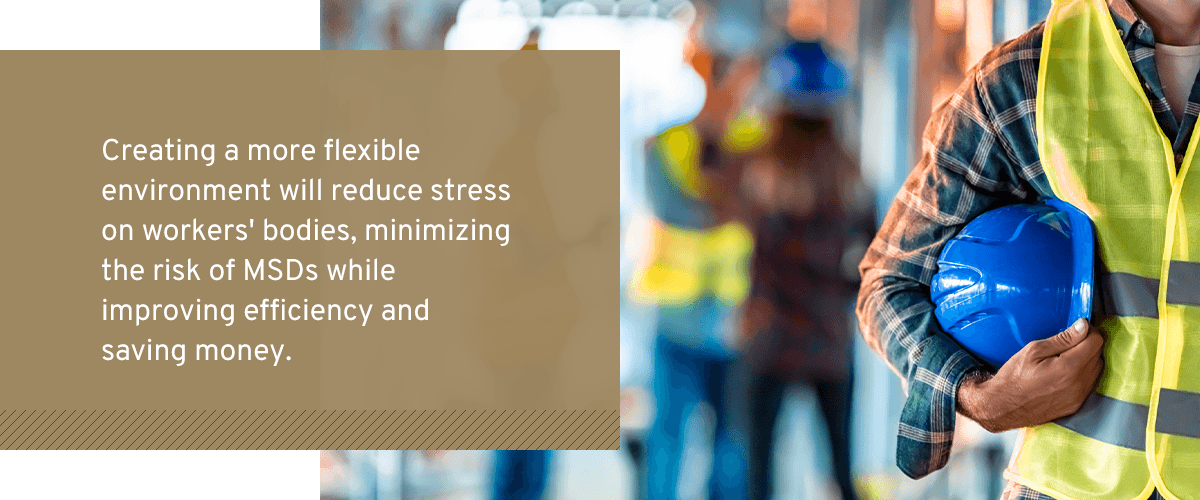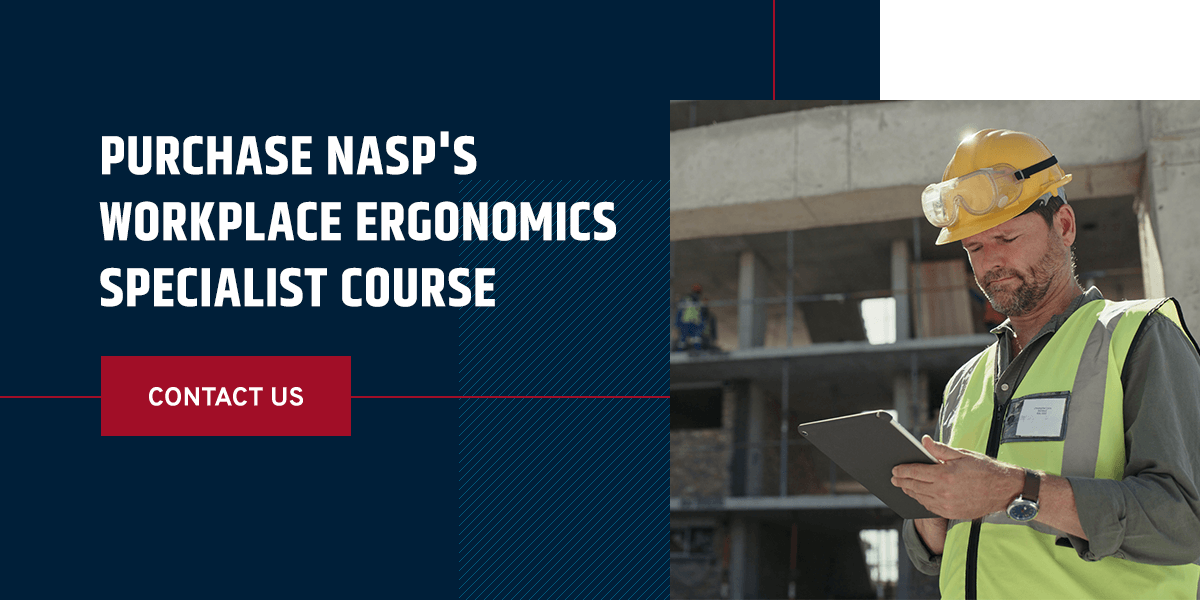Ergonomic Hazards and Safety Tips on the Job Site

The construction industry offers hands-on, intense environments that require hard work from all individuals involved despite the areas of these construction sites containing hazards and risks. Ergonomics is the science of creating an environment fitted to workers’ needs, attempting to eliminate risks of strain, injuries and fatigue through the design of tools, workspaces, and procedures.
Using these strategies and understanding how to avoid ergonomic hazards on the job site will improve worker satisfaction and boost efficiency — benefits for everyone.
Common Ergonomic Hazards on the Job Site
Wherever you look at a job site, you will likely find potential ergonomic hazards that could lead to future accidents and musculoskeletal disorders (MSDs), which are one of the fastest-growing threats to workplace safety. The mission of ergonomics is to identify and decrease risks throughout their environment. While your construction site may not look like a dangerous place at first glance, viewing it through the eyes of ergonomics will help you see it from your workers’ perspectives, understanding how they feel and how procedures and conditions impact them.
The most prevalent ergonomic hazards on the job site include:
- Force: Within construction sites, workers are often required to lift and carry heavy objects while also engaging in tasks that require extreme physical effort, such as pushing, pulling, pinching, hitting, pounding and jumping. These activities lead to unnecessary biomechanical stress, causing workers’ muscles to contract and fatigue quickly. When sustained for long periods, muscles are likely to become strained, leading to damage and soreness. Tendons, joints and discs may also become irritated, causing inflammation, fluid buildup and blood vessel constriction.
- Repetition: Construction workers perform repetitive tasks constantly, such as hammering, measuring and lifting. Performing these actions over and over without substantial breaks can cause significant wear and tear on the body. Areas like the wrists, hands, elbows, neck and shoulders could develop repetitive strain injury (RSI), causing problems like stiffness, throbbing, weakness, tingling and pain.
- Posture: Posture is the body’s position while performing various activities. On the job site, construction workers find themselves in awkward variations of normal posture, whether they’re reaching behind, working overhead or bending forward or backward. The more the joint diverges from a natural position, the more likely an injury is to occur. Workers’ bodies operate less efficiently in these deviated positions and use more force to complete the task.
- Environment: Poorly designed working environments negatively impact workers, further complicating existing ergonomic hazards on construction sites. You should look for common environmental hazards, including extreme temperatures, loud noises, poor lighting and humidity. With these factors present, your workers’ accidents and problems are more probable.
- Vibration: With the frequent use of power tools and heavy machinery, construction professionals are exposed to high amounts of vibration. Excessive vibrations from devices such as drills, grinders, and sanders can cause an assortment of issues, including a condition known as hand-arm vibration syndrome (HAVS). Vibration also disrupts the natural flow of oxygen and nutrients to different body parts, causing headaches, back pain and even carpal tunnel syndrome.
Ergonomic Safety Tips for the Job Site
When you’re ready to implement strategies to improve your ergonomics on the job site, remember the purpose of what you’re trying to do. These strategies aim to tailor the job better to fit your workers rather than forcing your workers to fit the job’s requirements.
Consider the following ergonomic safety tips for construction workers to meet their safety and psychological needs, and create a working environment suited to all types of people:
- Have signage or training instructing workers how to use and hold hand tools correctly.
- Ensure workers use correct personal protective equipment (PPE).
- Eliminate lifting using machinery.
- Utilize adjustable equipment to fit different body types and sizes.
- Allow adequate time for breaks throughout the day.
- Label all loads with the correct weight.
- Rotate workers to participate in other activities to avoid excessive repetition.
- Keep all areas clean and clear of obstructions.
- Design storage for easy access of materials and tools at waist height.
- Require two or more workers to lift loads over 50 pounds.
How to Improve Ergonomics on the Job Site
The first step to improving ergonomics on the job site is identifying potential problems or issues. Once this happens, you can move on to fixing them. Ergonomics revolves around finding ways to work easier while maintaining high productivity levels. Throughout your road to a more ergonomic site, you should be talking with your employees, involving them in the process to understand what areas they think are hazardous or physically straining and noting their concerns and suggested improvements.
Necessary changes will likely fall into the following categories:
- Facility: Before anything, you should conduct assessments to understand your site’s overall safety. These assessments and surveys will increase your knowledge and help you target hazards where controls are needed.
- Engineering controls: These are physical changes you can make to put a barrier between the danger and your workers. Using carts to minimize lifting, providing adjustable work tables or installing high-performance light fixtures are examples of possible engineering controls. These additions may cost more upfront, but you’ll see significant increases in protection and decreases in long-term operating costs.
- Administrative controls: Administrative controls are changes or implementations of certain procedures, programs and schedules to reduce the frequency and severity of construction ergonomic hazards. These controls could come in the form of rotating tasks and encouraging early reporting of MSD symptoms.
- Training: Thoroughly train construction workers to understand the impact of ergonomics and what they can do to lessen the chances of developing injuries. Inform them about proper lifting and carrying techniques, the importance of avoiding twisting and bending and how to use specific machines safely. These training times can also teach employees how to identify early signs of MSDs and how to handle them to limit injury severity.
Purchase NASP’s Workplace Ergonomics Specialist Course
At the National Association of Safety Professionals (NASP), we are leading the way in workplace safety training by providing companies across various industries with the information they need to keep their job sites safe and operating at maximum efficiency. NASP accomplishes its mission through providing professional certificates, classroom training, online training, on-site training and a variety of safety and environmental consulting services.
While we are more than capable of tailoring our services to meet your needs, our comprehensive certificates offer the required knowledge, skills and capabilities to become an expert in specified areas. At NASP, we offer a Workplace Ergonomics Specialist (WES) training program to help you identify potential ergonomic hazards on the job site and implement the best practices to prevent MSDs. If you’re interested in transforming how your construction site operates, purchase our WES course today, or contact our professionals online to learn more about how NASP can help you.
Purchase Our Workplace Ergonomics Specialist (WES) Course
Blog Posts
Latest Posts
Related Posts






